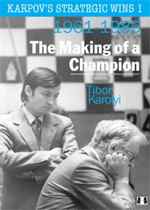Karpov’s Strategic Wins 1 (1961-1985)
The Making of a Champion
Tibor Karolyi
Karpov was, for many years, my favorite player. The depth of his strategic understanding boggled the mind, and his games reminded one of Petrosian in that Karpov had the same rare ability to wrap the opponent in his positional coils like a python and then squeeze him into submission. There have been many books about Karpov (a few by Karpov himself), but none take the reader on a year-by-year journey through his career like Karolyis book does.
Karpovs Strategic Wins 1 offers us a simple but very efficient and interesting format: From 1961 1985, each year is explored to some degree, offering (once he became a major player) his rating for the year, biographical information for each year, at least one deeply annotated game (and usually quite a few obviously, more and more games are presented as Karpov grows stronger), and a summary for that year that lists all his tournaments and matches for that time period plus a colorful circular graph showing his percentages of wins/losses/draws. The ability to easily follow his life, games, and stats makes for compelling reading.
I mentioned the games were all deeply annotated, but theres more to the notes than that. Karolyi not only gives deep variations and analysis, but he also discusses strategic ideas, and fills the notes with a very nice balance of moves and prose. Here are a couple examples of his smooth prose:
“This move was first played in 1974, although it is not completely clear whether or not it was technically Karpovs novelty, as there was another game without an exact date. In any case, Karpov writes in My Best Games that the move was an original idea for him. The move was also seen in a game between Samuel Reshevsky and Walter Browne in the 1974 US Championship, in which Black eventually prevailed.
“Material is level, but Black has a much better pawn structure. His passed a-pawn is an important asset which renders Whites Bishop very passive. Nevertheless, Whites position is difficult to penetrate and he should still be able to draw with accurate defence.
Other nice features: a bibliography, an index of strategic classifications (which makes it very easy to study a particular idea or theme), a game index by page number, a game index of Karpovs opponents, an alphabetical game index of non-Karpov games (i.e., games mentioned in the notes to Karpovs game), a name index, an overall index of statistics, scores against individual opponents (I always find this kind of thing enlightening), tournament record, and tournament summary. WOW! Its easy to see that lots of thought, planning, love, passion, and hard work were put into this magnificent book.
Karpovs Strategic Wins 1 gets my highest recommendation if you enjoy going over master games, are a fan of Karpov, or wish to study high-level positional concepts through the use of Karpovs games. This is, quite simply, one of the finest game collections Ive ever seen.
Read a review of Karpovs Strategic Wins 2.


